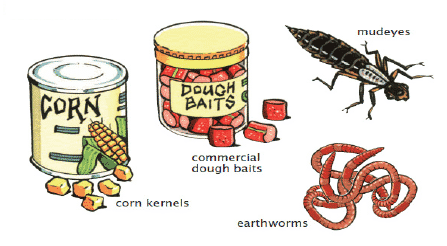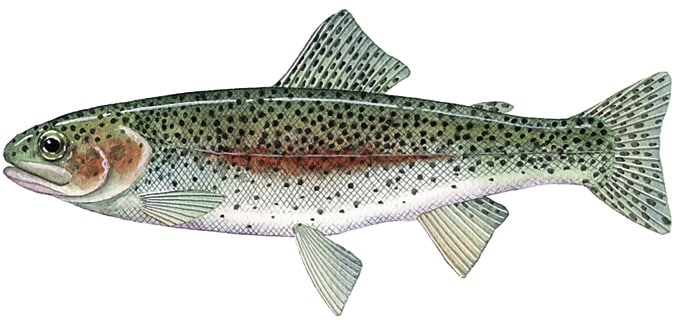Genus Oncorhynchus mykiss
Description
Rainbow trout are a medium-sized fish with a relatively small head. The upper body varies in colour from olive-green to steely-blue, the sides are silvery and the belly is white. A pink, red or crimson flash extends along the gill covering and sides of the body. The head, upper body, dorsal fin and tail are heavily marked with small black spots. In discoloured water they can loose these vivid markings and develop an overall silvery appearance. Rainbow trout are native to the western coastal rivers of North America and were first introduced to Australia in 1894 from New Zealand, where they had been relocated from California.
Distribution
Rainbow trout are a freshwater species found in lakes and streams throughout the cooler sections of the state, including the central highlands and south west districts. Populations are reliant on stockings by Fisheries Victoria. In lakes and reservoirs they can be found in both deep and shallow water.
Size
Rainbow trout caught by anglers in Victorian waters generally range in size from 250 grams up to 2 kilograms. Larger fish of 3 kg require an abundant and consistent food source, and are caught less commonly. Fish over 4 kg are very rare.
Fishing techniques and tackle
Rainbow trout are generally regarded as an easier species to catch than brown trout. A 1.8-2.1 metre rod with a matching reel and 2-3 kg line makes an effective outfit. Baits can either be fished on the bottom or under a quill or bubble float. Sinker weight should be kept to a minimum and hooks need to be small (size 6-10) and preferably chemically sharpened. Prime times to fish are around dawn and dusk, but they can be caught throughout the day, especially if the water is discoloured or the weather is overcast. A wide variety of lures including spoons and small bibbed hardbodies are effective, as are soft plastic lures which resemble small fish. Fly fishing with either wet or dry flies provides exciting fishing and wet flies can also be fished behind a bubble float on a spinning rod.


Baits
Rainbow trout feed opportunistically on small fish, molluscs, crustaceans and insects. Common live baits include scrubworms, minnows, maggots and mudeyes. Brightly coloured artificial baits made of dough are very effective and are available commercially. Other baits include corn kernels and salted whitebait.

Locations
Waters in central Victoria that are recognised for producing rainbow trout include Lake Wartook, Hepburn Lagoon, Newlyn Reservoir, Jubilee Lake and Kennington Reservoir. Productive waters in the south west include Lake Purrumbete and Lake Bullen Merri. For information on recent stockings contact the Victorian Fisheries Authority.
Sustainable fishing techniques
- Hook damage is the most significant cause of fish dying after being released. Deep-hooked (gills, gut) fish are far less likely to survive.
- Fish with a tight line so that fish are less likely to swallow the hook.
- Increase the size of your hooks to prevent small fish swallowing them.
- Avoid suspending fish on the hook.
- Fish hooked in the mouth or lip have the best chance of survival.
- Remove the hook with long nosed pliers.
- If you can’t see the whole hook protruding from the mouth of the fish don’t try and remove it.
- Cut the line and release the fish.
- Wet your hands before handling the fish.
- Avoid touching the gills and eyes.
- Return the fish as quickly as possible.



